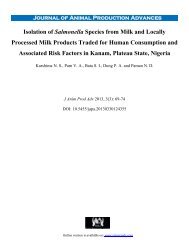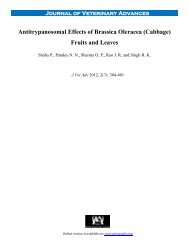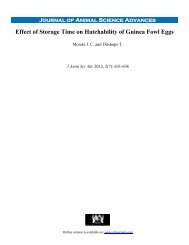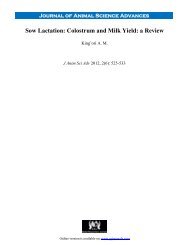Use of Ethnoveterinary Medicine in Family Poultry Health ...
Use of Ethnoveterinary Medicine in Family Poultry Health ...
Use of Ethnoveterinary Medicine in Family Poultry Health ...
Create successful ePaper yourself
Turn your PDF publications into a flip-book with our unique Google optimized e-Paper software.
Journal <strong>of</strong> Veter<strong>in</strong>ary Advances<br />
<strong>Use</strong> <strong>of</strong> <strong>Ethnoveter<strong>in</strong>ary</strong> <strong>Medic<strong>in</strong>e</strong> <strong>in</strong> <strong>Family</strong> <strong>Poultry</strong> <strong>Health</strong><br />
Management <strong>in</strong> Botswana: a Review<br />
Moreki J. C.<br />
J Vet Adv 2012, 2(6): 254-260<br />
Onl<strong>in</strong>e version is available on: www.grjournals.com
ISSN: 2251-7685<br />
MOREKI<br />
<strong>Use</strong> <strong>of</strong> <strong>Ethnoveter<strong>in</strong>ary</strong> <strong>Medic<strong>in</strong>e</strong> <strong>in</strong> <strong>Family</strong> <strong>Poultry</strong> <strong>Health</strong><br />
Management <strong>in</strong> Botswana: a Review<br />
A Review<br />
Moreki J. C.<br />
Department <strong>of</strong> Animal Science and Production, Botswana College <strong>of</strong> Agriculture,Private Bag 0027, Gaborone, Botswana<br />
Abstract<br />
A review <strong>of</strong> the utilization <strong>of</strong> ethnoveter<strong>in</strong>ary medic<strong>in</strong>e (EVM) for health management <strong>of</strong> family poultry <strong>in</strong><br />
Botswana was undertaken. The use <strong>of</strong> ethnoveter<strong>in</strong>ary medic<strong>in</strong>e <strong>in</strong> the management <strong>of</strong> animal healthcare is as<br />
old as the domestication <strong>of</strong> various livestock species. Compared to Western modern medic<strong>in</strong>e, EVM is widely<br />
utilized by the family poultry rearers across the country. In Botswana, the common traditional remedies used to<br />
control and treat diseases were Aloe spp., potassium permanganate and Nicotiana tabacum. Aloe spp. and N.<br />
tabacum were also used aga<strong>in</strong>st <strong>in</strong>ternal parasites while wood ashes, especially those from Peltophorum<br />
africanum and Combretum imberbe were used aga<strong>in</strong>st external parasites. Because <strong>of</strong> its unpleasant and strong<br />
smell, Thamnosma rhodesica leaves were placed <strong>in</strong> chicken shelters <strong>in</strong> order to repel external parasites. This<br />
review suggests the need to conduct field surveys <strong>in</strong> order to document ethnoveter<strong>in</strong>ary practices <strong>in</strong> Botswana.<br />
Keywords: Diseases, family poultry, herbal plants, parasites, traditional remedies<br />
Correspond<strong>in</strong>g author: Department <strong>of</strong> Animal Science and Production, Botswana College <strong>of</strong> Agriculture,Private Bag 0027, Gaborone, Botswana<br />
Received on: 15 May 2012<br />
Revised on: 07 June 2012<br />
Accepted on: 16 June 2012<br />
Onl<strong>in</strong>e Published on: 30 June 2012<br />
254 J. Vet. Adv., 2012, 2(6):254-260
USE OF ETHNOVETERINARY MEDICINE IN FAMILY POULTRY …<br />
Introduction<br />
<strong>Ethnoveter<strong>in</strong>ary</strong> medic<strong>in</strong>e (EVM), which is<br />
also known as traditional animal health care<br />
practices, is def<strong>in</strong>ed as local or <strong>in</strong>digenous<br />
knowledge and methods for car<strong>in</strong>g, heal<strong>in</strong>g, and<br />
manag<strong>in</strong>g livestock (Guéye, 1999). It is the study <strong>of</strong><br />
<strong>in</strong>digenous knowledge system <strong>of</strong> animal health care.<br />
The EVM drugs are used <strong>in</strong> the management <strong>of</strong><br />
bacterial, viral, protozoan, fungal, parasitic and non<strong>in</strong>fectious<br />
causes <strong>of</strong> diseases. Accord<strong>in</strong>g to Sri<br />
Balaji and Vikrama Chakravarthi (2010),<br />
ethnoveter<strong>in</strong>ary practices concern to animal health<br />
care is as old as the domestication <strong>of</strong> various<br />
livestock species. They comprise beliefs,<br />
knowledge, practices and skills perta<strong>in</strong><strong>in</strong>g to health<br />
care and management <strong>of</strong> livestock. Worldwide the<br />
people have traditionally relied on a whole range <strong>of</strong><br />
<strong>in</strong>digenous practices to keep their flock health and<br />
to treat them when they are sick (Anon, 1996).<br />
Medic<strong>in</strong>al plants have for several centuries been<br />
widely used as a primary source <strong>of</strong> prevention and<br />
control <strong>of</strong> livestock diseases (Hoareau and DaSilva,<br />
1999). In the op<strong>in</strong>ion <strong>of</strong> Guèye (1997), EVM is<br />
usually the only alternative for most <strong>of</strong> the resourcepoor<br />
family poultry farmers, particularly <strong>in</strong> rural<br />
and hilly areas because there are almost no<br />
veter<strong>in</strong>arians work<strong>in</strong>g <strong>in</strong> such areas.<br />
Accord<strong>in</strong>g to Wanzala et al. (2005), the<br />
discovery <strong>of</strong> all the medic<strong>in</strong>al uses <strong>of</strong> plants must<br />
have occurred <strong>in</strong> a number <strong>of</strong> ways, not only by the<br />
pr<strong>in</strong>ciple <strong>of</strong> trial and error mechanism. Some <strong>of</strong><br />
these ways <strong>in</strong>clude watch<strong>in</strong>g animals treat<br />
themselves by eat<strong>in</strong>g and rubb<strong>in</strong>g themselves with<br />
special plants when ill (zoopharmacognosy) and<br />
subsequent adoption <strong>of</strong> the same remedies,<br />
communicat<strong>in</strong>g and <strong>in</strong>teract<strong>in</strong>g with the visit<strong>in</strong>g<br />
traditional medical specialists from other<br />
communities and borrow<strong>in</strong>g their traditional<br />
remedial ideas, <strong>in</strong>herit<strong>in</strong>g the heal<strong>in</strong>g powers and<br />
magic from parents, buy<strong>in</strong>g the heal<strong>in</strong>g and magic<br />
powers from experienced traditional medical<br />
specialists and deliberate experimentation to help<br />
select those remedies that work. Guèye (2002) and<br />
Masimba et al. (2011) po<strong>in</strong>ted out that<br />
ethnoveter<strong>in</strong>ary knowledge was mostly <strong>in</strong> the<br />
custody <strong>of</strong> older men and women who passed it<br />
orally to younger gerenations by word <strong>of</strong> mouth.<br />
Interest <strong>in</strong> EVM has resulted primarily from the<br />
<strong>in</strong>creas<strong>in</strong>g cost <strong>of</strong> livestock ma<strong>in</strong>tenance and the<br />
<strong>in</strong>troduction <strong>of</strong> new technology <strong>in</strong> the production <strong>of</strong><br />
veter<strong>in</strong>ary medic<strong>in</strong>es and vacc<strong>in</strong>es (Hoareau and<br />
DaSilva, 1999). In Kenya, Lagu and Kayanja(2010)<br />
reported that traditional healers play limited roles <strong>in</strong><br />
treat<strong>in</strong>g local chickens as many farmers collect,<br />
concoct and adm<strong>in</strong>ister the local herbs themselves.<br />
Many <strong>of</strong> the plants used to prepare <strong>in</strong>digenous<br />
medic<strong>in</strong>e conta<strong>in</strong> valuable active <strong>in</strong>gredients.<br />
Previous study by Moreki et al. (2010) showed that<br />
86.7% <strong>of</strong> family poultry rearers used EVM, whereas<br />
the rema<strong>in</strong>der used modern medic<strong>in</strong>es (vacc<strong>in</strong>es and<br />
drugs).<br />
Resource-poor farmers <strong>in</strong> rural and peri-urban<br />
areas have limited access to veter<strong>in</strong>ary care <strong>in</strong> terms<br />
<strong>of</strong> support services (from state and private<br />
veter<strong>in</strong>arians and animal health technicians),<br />
<strong>in</strong>formation about the prevention and treatment <strong>of</strong><br />
livestock diseases, and preventative and therapeutic<br />
veter<strong>in</strong>ary medic<strong>in</strong>es (Dold and Cocks, 2001). Also,<br />
the resource-poor family poultry farmers do not<br />
have money for, or access to cost-<strong>in</strong>tensive<br />
management systems <strong>in</strong>clud<strong>in</strong>g chemical medic<strong>in</strong>e<br />
(Guèye, 2002).<br />
The <strong>in</strong>digenous traditional knowledge <strong>of</strong><br />
medic<strong>in</strong>al plants <strong>of</strong> various ethnic communities,<br />
which has been transmitted orally for centuries is<br />
fast disappear<strong>in</strong>g from the face <strong>of</strong> the earth due to<br />
the advent <strong>of</strong> modern technology and<br />
transformation <strong>of</strong> traditional culture (Sandhya et al.,<br />
2006). Therefore, the paper reviews published<br />
researches on the use <strong>of</strong> EVM <strong>in</strong> family poultry<br />
with particular reference to Botswana.<br />
Merits and demerits for the use <strong>of</strong><br />
ethnoveter<strong>in</strong>ary medic<strong>in</strong>e<br />
Guèye (1997) stated that the use <strong>of</strong> EVM is<br />
susta<strong>in</strong>able and ecologically sound, as plant<br />
products with recognised medic<strong>in</strong>al properties are<br />
far more accessible to the villagers than Western<br />
medic<strong>in</strong>e. The merits and demerits for the use <strong>of</strong><br />
EVM are presented <strong>in</strong> Table 1.<br />
255 J. Vet. Adv., 2012, 2(6):254-260
MOREKI<br />
Table 1: Merits and demerits for the use <strong>of</strong> ethnoveter<strong>in</strong>ary medic<strong>in</strong>e<br />
Merits<br />
Demerits<br />
Cost effective<br />
Difficulty <strong>of</strong> gett<strong>in</strong>g plants at certa<strong>in</strong> times <strong>of</strong> the year.<br />
Local medic<strong>in</strong>es are effective<br />
Delays <strong>in</strong> the recovery <strong>of</strong> the birds post herbal drug<br />
adm<strong>in</strong>istration.<br />
Readily accessible<br />
Difficulty <strong>in</strong> preservation <strong>of</strong> the herbal concoctions.<br />
There is no em<strong>in</strong>ent resistance<br />
Ineffective concoctions, unknown dosages and therefore not<br />
standardized.<br />
No transport costs are <strong>in</strong>curred<br />
May be harmful to persons prepar<strong>in</strong>g them<br />
It is easy to adm<strong>in</strong>ister<br />
The tedious process <strong>of</strong> prepar<strong>in</strong>g herbal concoctions for many<br />
birds.<br />
There is m<strong>in</strong>imal risk <strong>of</strong> drug overdose<br />
There are no known dosages.<br />
When prompt treatment is adm<strong>in</strong>istered, the birds Not sure <strong>of</strong> the diseases be<strong>in</strong>g treated because <strong>of</strong> poor<br />
get healed and the birds benefit from<br />
diagnosis, which only identifies symptoms and not the<br />
supplementation from vitam<strong>in</strong>s.<br />
underly<strong>in</strong>g cause.<br />
Source: Matekaire and Bwakura (2004); Lagu and Kayanja (2010).<br />
Medic<strong>in</strong>al plant parts used<br />
The distribution <strong>of</strong> medic<strong>in</strong>al plants <strong>in</strong> poultry<br />
health management by parts utilized for EVM is<br />
shown <strong>in</strong> Figure 1. The most used part is the root<br />
and the least used part is the wood. In their study,<br />
Bodeker et al. (2005) reported that the destructive<br />
harvest<strong>in</strong>g methods (roots, whole plants, bark, stem,<br />
rhizomes and wood) and non-destructive methods<br />
(fruits, seeds, leaves and flowers) accounted for<br />
72% and 28%, respectively <strong>of</strong> plants parts used <strong>in</strong><br />
EVM.Sri Balaji and Vikrama Chakravarthi (2010)<br />
stated that all plant parts <strong>in</strong>clud<strong>in</strong>g leaves, bark,<br />
fruits, flowers and seeds are used <strong>in</strong> medic<strong>in</strong>al<br />
preparations.<br />
Fig. 1: Distribution <strong>of</strong> medic<strong>in</strong>al plants by parts used. Source: Bodeker et al. (2005)<br />
Preparation and application <strong>of</strong> herbal<br />
medic<strong>in</strong>es<br />
Plants are the most commonly utilized<br />
<strong>in</strong>gredients <strong>in</strong> the preparation <strong>of</strong> EVM. Masika et al.<br />
(2000) noted that medic<strong>in</strong>al plants have various<br />
methods <strong>of</strong> preparation and application such as<br />
concoction, decoction, powder, and crushed and<br />
homogenized <strong>in</strong> water for different types <strong>of</strong><br />
ailments. Preparation can be made from s<strong>in</strong>gle plant<br />
or from a range <strong>of</strong> plants depend<strong>in</strong>g on the disease<br />
treated. The preparation and application methods<br />
vary based on the type <strong>of</strong> disease treated and the<br />
256 J. Vet. Adv., 2012, 2(6):254-260
USE OF ETHNOVETERINARY MEDICINE IN FAMILY POULTRY …<br />
actual site <strong>of</strong> the ailment. The medic<strong>in</strong>al plant<br />
preparations are applied through different routes <strong>of</strong><br />
adm<strong>in</strong>istration such as oral, topical or dermal, and<br />
nasal routes.<br />
The most common forms <strong>of</strong> EVM preparations<br />
are powders, poultice, o<strong>in</strong>tment, decoction,<br />
<strong>in</strong>fusion, cold ware extract, t<strong>in</strong>cture and fumigation<br />
(Toyang et al., 2007; Sri Balaji and Vikrama<br />
Chakravarthi, 2010). A study by Masika et al.<br />
(2000) <strong>in</strong> South Africa, reported that a concoction<br />
constituted 26.1% <strong>of</strong> preparation form, followed by<br />
crushed and homogenized <strong>in</strong> water (20%) and<br />
powder form (16.1%). The authors observed that<br />
oral application was the most (50.43%) commonly<br />
used route followed by topical or dermal application<br />
(23.48%).<br />
<strong>Ethnoveter<strong>in</strong>ary</strong> medic<strong>in</strong>es can be adm<strong>in</strong>istered<br />
<strong>in</strong> many different ways <strong>in</strong>clud<strong>in</strong>g drench<strong>in</strong>g, bath,<br />
fumigation, spray, <strong>in</strong>jection and topical application<br />
(Toyang et al., 2007). Drench<strong>in</strong>g is apply<strong>in</strong>g<br />
medic<strong>in</strong>e <strong>in</strong> liquid form through the mouth us<strong>in</strong>g a<br />
spoon, dropper or sorghum straw; on sk<strong>in</strong><br />
application a poultice, s<strong>of</strong>t heated preparation<br />
(applied to a sore or abscess us<strong>in</strong>g wet cloth), warm<br />
stone or direct application; fumigation (the use <strong>of</strong><br />
smoke to kill <strong>in</strong>sects); steam (applied to affected<br />
part); hang<strong>in</strong>g bouquet (when plants parts are bound<br />
<strong>in</strong> to a bouquet and hanged <strong>in</strong>side poultry house); <strong>in</strong><br />
the eye application (medic<strong>in</strong>e is dropped <strong>in</strong>to the<br />
eye <strong>of</strong> the bird) and lastly medic<strong>in</strong>e can be applied<br />
through feeds or water by mix<strong>in</strong>g them with<br />
medic<strong>in</strong>e.<br />
Diseases control and t treatment through<br />
ethnoveter<strong>in</strong>ary medic<strong>in</strong>e<br />
Diseases seriously affect family poultry and<br />
constitute one <strong>of</strong> its major threats. Moreki et al.<br />
(2010) ascribed losses <strong>in</strong> family poultry to diseases<br />
(36.7%); diseases and parasites (11.1%); predation<br />
(8.89%); a comb<strong>in</strong>ation <strong>of</strong> diseases, parasites and<br />
predation (8.89%). In order <strong>of</strong> prevalence, the<br />
common diseases <strong>of</strong> poultry <strong>in</strong> Botswana are<br />
coccidiosis, <strong>in</strong>fectious coryza, fowl pox, <strong>in</strong>fectious<br />
bursal disease (IBD) and Newcastle disease (NCD)<br />
(Moreki et al., 2011). Accord<strong>in</strong>g to Guéye (1999),<br />
NCD is the most widespread <strong>in</strong>fectious disease <strong>in</strong><br />
Africa. Similarly, Moreki (1997, 2010)<br />
identifiedNCD to be a major constra<strong>in</strong>t <strong>in</strong> family<br />
poultry, caus<strong>in</strong>g up to 100% mortality <strong>in</strong> unprotected<br />
flocks. The study <strong>of</strong> Badubi et al. (2006) <strong>in</strong><br />
Botswana estimated deaths due to NCD, predation,<br />
other causes and unknown causes to be 40.45%,<br />
53.8%, 3.3% and 2.55%, respectively. Herbal plants<br />
used to treat and/or control diseases and parasites are<br />
presented <strong>in</strong> Table 2.<br />
As shown <strong>in</strong> Table 2, various herbal plants are<br />
used to treat, prevent and control diseases <strong>in</strong> family<br />
chickens. The study <strong>of</strong> Moreki (2003) showed that<br />
87% <strong>of</strong> respondents used traditional remedies to<br />
control diseases compared to 15% that used modern<br />
medic<strong>in</strong>es (2% vacc<strong>in</strong>es and 13% drugs). Both<br />
human and veter<strong>in</strong>ary medications were used <strong>in</strong> the<br />
treatment <strong>of</strong> diseases. The three common traditional<br />
remedies used by rearers were potassium<br />
permanganate, aloes (Aloe spp.) and leaf tobacco<br />
(Nicotiana tabacum). The medic<strong>in</strong>al uses <strong>of</strong> tobacco<br />
have been reported <strong>in</strong> humans by Charlton (2004).<br />
In agreement with Moreki (1997), Deeba (2009) <strong>in</strong><br />
Pakistan reported the use <strong>of</strong> N. tabacum <strong>in</strong><br />
treatment <strong>of</strong> NCD. Other remedies <strong>in</strong>cluded<br />
Hypagophytum procumbens (tuber), salty water,<br />
exudates from eucalyptus (Eucalyptus spp.) leaves,<br />
roots from Senna italica, and a decoction <strong>of</strong> tea<br />
leaves (Five Roses Tea brand be<strong>in</strong>g preferred) for<br />
the treatment <strong>of</strong> various diseases. Similarly,<br />
Ranwedzi (2002) <strong>in</strong> South Africa reported that<br />
family poultry rearers used traditional remedies<br />
<strong>in</strong>clud<strong>in</strong>g Aloe vossii Reynolds and tobacco leaves<br />
to treat chickens aga<strong>in</strong>st NCD. Moreki (1997)<br />
attributed the wide use <strong>of</strong> traditional remedies to lack<br />
<strong>of</strong> knowledge <strong>in</strong> the use <strong>of</strong> vacc<strong>in</strong>es, lack <strong>of</strong> cool<strong>in</strong>g<br />
facilities, unavailability <strong>of</strong> vacc<strong>in</strong>es, and possible<br />
effectiveness <strong>of</strong> the remedies <strong>in</strong> cur<strong>in</strong>g some<br />
diseases. In Nigeria, Musa et al. (2008) noted that<br />
these remedies that are used by rural farmers may or<br />
may not have direct effect on NCD virus but could<br />
affect protozoan and helm<strong>in</strong>ths parasites <strong>of</strong> rural<br />
poultry by reduc<strong>in</strong>g the parasites burden, and<br />
boost<strong>in</strong>g the immunity <strong>of</strong> birds aga<strong>in</strong>st <strong>in</strong>fection.<br />
In Botswana, Aloe vera and N. tabacum are the<br />
most common utilized remedies used aga<strong>in</strong>st both<br />
diseases and parasites. Mwale et al. (2005) reported<br />
that A.vera and Aloe spicata were the predom<strong>in</strong>antly<br />
used plant species for chicken health management <strong>in</strong><br />
Zimbabwe. The authors attributed the wide use <strong>of</strong><br />
A.vera and A. spicata their ease <strong>of</strong> use and<br />
257 J. Vet. Adv., 2012, 2(6):254-260
MOREKI<br />
availability all year round. In agreement with<br />
Moreki et al. (2010), Mwale et al. (2005) mentioned<br />
that A.vera acts like a broadspectrum antibiotic<br />
remedy.<br />
Table 2: Herbal plants used to treat family poultry diseases <strong>in</strong> Botswana<br />
Tswana name English name Scientific name <strong>Family</strong> Parts used<br />
Kwii Onion Allium cepa Liliaceae Bulb<br />
* Garlic Allium sativum Liliaceae Bulb<br />
Mokgwapha Burn plant Aloe spp. Aloaceae Leaf<br />
Sengaparile Grapple plant Hypagophytum Pedaliaceae Tuber<br />
procumbens<br />
Sebete * Senna italica Fabaceae Roots<br />
Mmurubere Mulberry Morus alba Moraceae Leafs<br />
Moralala * Thamnosma rhodesica Rutaceae Roots<br />
Mosetlha African wattle Peltophorum africanum Caesalp<strong>in</strong>ioideae Root/bark<br />
Pepere Eucalyptus Eucalyptus spp. Myrtaceae Leaf<br />
Mabolara Tobacco Nicotiana tabacum Solanaceae Leaf<br />
Monepenepe Long-tail Cassia abbreviata Fabaceae Bark/roots<br />
cassia<br />
* Mor<strong>in</strong>ga Mor<strong>in</strong>ga oleifera Mor<strong>in</strong>gaceae Leaf<br />
Motswere Leadwood Combretum imberbe Combretaceae Whole<br />
plant<br />
Pherehere Pepper/chilli Capsicum annum Solanaceae Fruits<br />
*Name could not be found<br />
Moreeng (2008) reported that feed<strong>in</strong>g chickens<br />
a concoction <strong>of</strong> Mor<strong>in</strong>ga (Mor<strong>in</strong>ga oleifera) tree<br />
leaves is an effective de-worm<strong>in</strong>g practice. The use<br />
<strong>of</strong> Mor<strong>in</strong>ga oleifera by the rearers is consistent with<br />
Yang et al. (2006) who <strong>in</strong>vestigated the effects <strong>of</strong><br />
feed<strong>in</strong>g four levels (0.5%, 1%, 2% and 3% dried<br />
leaves) <strong>of</strong> dehydrated leaves <strong>of</strong> M. oleifera <strong>in</strong> the<br />
diets <strong>of</strong> broilers and found that Mor<strong>in</strong>ga diets<br />
significantly (1) enhanced duodenum traits; (2)<br />
<strong>in</strong>creased concentrations <strong>of</strong> total globul<strong>in</strong>, γ-<br />
globul<strong>in</strong> and IgA, lymphocyte ratio, antibody titer<br />
to sheep erythrocytes, and delayed type<br />
hypersensitivity (3) reduced E. coli and <strong>in</strong>creased<br />
Lactobacillus counts <strong>in</strong> the ileum. The authors<br />
concluded that M. oleifera leaves are potential plant<br />
material to enhance immune responses and improve<br />
<strong>in</strong>test<strong>in</strong>al health <strong>of</strong> broilers. The study <strong>of</strong> Ogbe and<br />
Affiku (2011) <strong>in</strong> Nigeria showed that M. oleifera<br />
leaves conta<strong>in</strong>ed appreciable amounts <strong>of</strong><br />
carbohydrate, prote<strong>in</strong> and m<strong>in</strong>erals, which are<br />
nutritional requirements for poultry. The authors<br />
also mentioned that M. oleifera could be useful as<br />
feed supplement and as medic<strong>in</strong>e <strong>in</strong> poultry to<br />
improve health and growth performance.<br />
In Botswana, the bursa <strong>of</strong> fabricius <strong>of</strong> birds<br />
<strong>in</strong>fected with IBD is usually cut and dressed with<br />
salt or a mixture <strong>of</strong> salt and snuff (powdered<br />
tobacco) <strong>in</strong> order to stop bleed<strong>in</strong>g. The practice <strong>of</strong><br />
trimm<strong>in</strong>g bursa <strong>of</strong> fabricius is common across<br />
Botswana as it is said to be effective aga<strong>in</strong>st IBD<br />
(Moreki et al 2010). The study <strong>of</strong> Sima<strong>in</strong>ga et al.<br />
(2010) <strong>in</strong> the Western Prov<strong>in</strong>ce <strong>of</strong> Zambia reported<br />
similar results.<br />
Parasites control through ethnoveter<strong>in</strong>ary<br />
medic<strong>in</strong>e<br />
The common parasites <strong>of</strong> family poultry <strong>in</strong><br />
Botswana are tampans, mites, fowl lice and ticks,<br />
whereas the three common remedies used aga<strong>in</strong>st<br />
external parasites control are paraff<strong>in</strong>, wood ash and<br />
Blue Death (a chemical dust used to kill ants)<br />
(Moreki, 2003). These remedies are applied on the<br />
birds by rubb<strong>in</strong>g. Warm or cold ash is also applied<br />
to the floor <strong>of</strong> the shelters. Moreki (1997)<br />
mentioned that although ashes from any tree species<br />
could be used, Peltophorum africanum (African<br />
wattle) and Combretum imberbe (lead wood) are<br />
preferred. Other traditional remedies used to kill<br />
parasites are Aloe spp., Jeyes fluid, potassium<br />
permanganate and burn<strong>in</strong>g (smok<strong>in</strong>g) <strong>in</strong> the chicken<br />
shelters. It is claimed (Moreki, 1997) that plac<strong>in</strong>g<br />
the leaves <strong>of</strong> Thamnosma rhodesica <strong>in</strong> the chicken<br />
258 J. Vet. Adv., 2012, 2(6):254-260
USE OF ETHNOVETERINARY MEDICINE IN FAMILY POULTRY …<br />
shelter repels parasites. Similarly, Lagu and<br />
Kayanja (2010) <strong>in</strong> Uganda reported the use <strong>of</strong><br />
paraff<strong>in</strong> aga<strong>in</strong>st mites and fleas. The authors stated<br />
that A.vera was mixed with ash and red pepper<br />
(Capsicum annum) before adm<strong>in</strong>istration while <strong>in</strong><br />
Botswana an <strong>in</strong>fusion <strong>of</strong> A. vera is given.<br />
Conclusion<br />
Most family poultry are threatened by disease<br />
outbreak, especially NCD. <strong>Family</strong> poultry is usually<br />
owned and managed by resource-poor farmers who<br />
are unable to buy expensive vacc<strong>in</strong>es for their<br />
flocks. These vacc<strong>in</strong>es require cold cha<strong>in</strong> that is<br />
lack<strong>in</strong>g <strong>in</strong> the village environment. As a result,<br />
EVM is crucial <strong>in</strong> preserv<strong>in</strong>g the health <strong>of</strong> family<br />
poultry because it is cheap, readily available and<br />
cost effective. The EVM preparation and<br />
adm<strong>in</strong>istration varies from place to place and also<br />
differs depend<strong>in</strong>g on the diseases treated.Medic<strong>in</strong>al<br />
plants should be conserved, cultivated and<br />
harvested strategically to preserve them for future<br />
use. Further studies are required <strong>in</strong> order to<br />
document ethnoveter<strong>in</strong>ary practices used for health<br />
management <strong>of</strong> family poultry.<br />
Acknowledgement<br />
I would like to express my gratitude to Ms.<br />
Kenaleone Gabanakgosi, MSc. (Animal Science)<br />
student at Botswana College <strong>of</strong> Agriculture for<br />
assistance with some literature.<br />
References<br />
Anon (1996). <strong>Ethnoveter<strong>in</strong>ary</strong> medic<strong>in</strong>e <strong>in</strong> Kenya: Afield<br />
manual <strong>of</strong> traditional animal health care practices.<br />
International Technology Development Group (ITDG)<br />
and International Institute <strong>of</strong> Rural Reconstruction<br />
(IIRR), Nairobi, Kenya.<br />
Badubi SS, Rakereng M, Marumo M (2006). Morphological<br />
characteristics and feed resources available for<br />
<strong>in</strong>digenous chickens <strong>in</strong> Botswana.Livest.Res. Rural Dev.,<br />
14(5). Retrieved 05 May 2012 from<br />
http://www.lrrd.org/lrrd18/1/badu18003.htm<br />
Bodeker G, Bhat KKS, Burley J, Vantomme P<br />
(2005).Medic<strong>in</strong>al plants for forest conservation and<br />
health care, non-wood forest products. Daya Publish<strong>in</strong>g<br />
House. Delhi.<br />
Charlton A (2004). Medic<strong>in</strong>al uses <strong>of</strong> tobacco <strong>in</strong> history. J. R.<br />
Soc. Med., 97: 292-298.<br />
Deeba F (2009). Documentation <strong>of</strong> ethnoveter<strong>in</strong>ary practices<br />
<strong>in</strong> urban and peri-urban areas <strong>of</strong> Faisalabad (Pakistan).<br />
Doctor <strong>of</strong> Philosophy <strong>in</strong> Cl<strong>in</strong>ical <strong>Medic<strong>in</strong>e</strong> and Surgery<br />
Thesis.University <strong>of</strong> Agriculture, Faisalabad, Pakistan.<br />
Dold AP, Cocks ML (2001). Traditional veter<strong>in</strong>ary medic<strong>in</strong>e<br />
<strong>in</strong> the Alice district <strong>of</strong> the Eastern Cape Prov<strong>in</strong>ce, South<br />
Africa. South Afr. J. Sci., 97: 375-379.<br />
Guèye EF (2002). Newcastle disease <strong>in</strong> family poultry:<br />
prospects for its control through ethnoveter<strong>in</strong>ary<br />
medic<strong>in</strong>e. Livest.Res. Rural Dev., 14(5). Retrieved 10<br />
May 2012<br />
fromhttp://www.cipav.org.co/lrrd/lrrd14/5/guey145.htm<br />
Guèye EF (1999). <strong>Ethnoveter<strong>in</strong>ary</strong> medic<strong>in</strong>e aga<strong>in</strong>st poultry<br />
diseases <strong>in</strong> African villages.World's Poult. Sci. J., 55:<br />
187-198.<br />
Guèye EF (1997). Diseases <strong>in</strong> village chickens: Control<br />
through ethnoveter<strong>in</strong>ary medic<strong>in</strong>e. ILEIA Newsletter,<br />
13(2): 20-21.<br />
Hoareau L, DaSilva EJ (1999). Medic<strong>in</strong>al plants: a reemerg<strong>in</strong>g<br />
health aid. EJB Electronic J. Biotechnol., 2(2):<br />
56-70.<br />
Lagu C, Kayanja FIB (2010).Medic<strong>in</strong>al plant extracts widely<br />
used <strong>in</strong> the control <strong>of</strong> Newcastle disease (NCD) and<br />
helm<strong>in</strong>thosis among village chickens <strong>of</strong> South Western<br />
Uganda. Livest.Res. Rural Dev., 22(200).Retrieved from<br />
on the 24 October 2011 from<br />
http://www.lrrd.org/lrrd22/11/lagu22200.htm<br />
Masika PJ, van Averbeke W, Sonandi A (2000).<strong>Use</strong> <strong>of</strong> herbal<br />
remedies by small-scale farmers to treat livestock<br />
diseases <strong>in</strong> Central Eastern Cape Prov<strong>in</strong>ce, South<br />
Africa.Proceed<strong>in</strong>gs INFPD workshop, M’Bour, Senegal,<br />
December 9-13, 1997. Retrieved on 21 October 2011<br />
from http://www.ncbi.nlm.nih.gov/pubmed/11030357#<br />
Masimba ES, Mbiriri DT, Kashangura MT, Mutibvu T<br />
(2011).Indigenous practices for the control and treatment<br />
<strong>of</strong> ailments <strong>in</strong> Zimbabwe’s village poultry. Livest.Res.<br />
Rural Dev., 23 (12). Retrieved 6 th May 2012, from<br />
http://www.lrrd.org/lrrd23/12/masi23257.htm<br />
Matekaire T, Bwakura TM (2004). <strong>Ethnoveter<strong>in</strong>ary</strong> medic<strong>in</strong>e:<br />
A potential alternative to orthodox animal health delivery<br />
<strong>in</strong> Zimbabwe. Intern. J. Appl. Res. Vet. Med., 2(4): 269-<br />
273.<br />
Moreeng A (2008). Mor<strong>in</strong>ga - Immune Booster or<br />
Snake Oil? The Botswana Gazette Newspaper,<br />
Tuesday, 12 August 2008.<br />
Moreki JC (1997).Small-scale poultry production systems <strong>in</strong><br />
Serowe-Palapye Sub-district (Botswana).Master <strong>of</strong><br />
Applied Science (Agriculture) Thesis, University <strong>of</strong><br />
Melbourne, Melbourne, Australia.<br />
Moreki JC, Masupu KV (2001).Country Report: Botswana.<br />
In, Alders RG and Spradbrow P B (Editors) SADC<br />
Plann<strong>in</strong>g Workshop on Newcastle Disease Control <strong>in</strong><br />
village chickens. Proceed<strong>in</strong>gs <strong>of</strong> an International<br />
Workshop, Maputo, Mozambique, 6-9 March, 2000.<br />
ACIAR Proceed<strong>in</strong>gs No. 103.5-10.<br />
Moreki JC (2003). Village <strong>Poultry</strong> and poverty alleviation.In,<br />
Community-based management <strong>of</strong> animal genetic<br />
259 J. Vet. Adv., 2012, 2(6):254-260
MOREKI<br />
resources. Proceed<strong>in</strong>gs <strong>of</strong> workshop held <strong>in</strong> Mbabane,<br />
Swaziland, 7-11 May 2001.<br />
Moreki JC (2010). Village poultry production <strong>in</strong> Serowe-<br />
Palapye sub-district <strong>of</strong> Botswana.Livest.Res. Rural Dev.,<br />
22 (3).Retrieved on 7 May 2012 from<br />
http://www.lrrd.org/lrrd22/3/more22046.htm<br />
Moreki JC, Poroga B, Dikeme R, Seabo D (2010).<br />
<strong>Ethnoveter<strong>in</strong>ary</strong> medic<strong>in</strong>e and health management <strong>in</strong><br />
poultry <strong>in</strong> Southern and Western Districts,<br />
Botswana.Livest.Res. Rural Dev., 22 (6).Retrieved on 5<br />
November 2011 from<br />
http://www.lrrd.org/lrrd22/6/more22107.htm<br />
Moreki JC, Chiripasi SC, Montsho T, Chibua R, Gabanakgosi<br />
K (2011).Prevalence <strong>of</strong> poultry disease and parasites <strong>in</strong><br />
Botswana.Onl<strong>in</strong>e J. Anim. Feed Res., 1(5): 214-217.<br />
Musa U, Abdul PA, DwafangII, Katsayal UA, Edache JA,<br />
Kars<strong>in</strong> PD (2008). <strong>Ethnoveter<strong>in</strong>ary</strong> remedies used for the<br />
management <strong>of</strong> Newcastle disease <strong>in</strong> some selected local<br />
government areas <strong>of</strong> Plateau State Nigeria. Nig. Journ.<br />
Pharm. Sci., 7(1): 126-130.<br />
Mwale M, Bhebhe E, Chimoyo M, Halimani TE (2005).<strong>Use</strong><br />
<strong>of</strong> herbal plants <strong>in</strong> poultry health management <strong>in</strong> the<br />
Mushagashe small-scale commercial farm<strong>in</strong>g area <strong>in</strong><br />
Zimbabwe.Intern. J. Appl. Res. Vet. Med., 3(2): 163-<br />
170.<br />
Ogbe AO, Affiku JP (2011).Proximate study, m<strong>in</strong>eral and<br />
anti-nutrient composition <strong>of</strong> Mor<strong>in</strong>ga oleifera leaves<br />
harvested from Lafia, Nigeria: Potential benefits <strong>in</strong><br />
poultry nutrition and health. J.Microbiol.Biotechnol.<br />
Food Sci., 1(3): 296-308.<br />
Ranwedzi NE (2002). An evaluation <strong>of</strong> family poultry<br />
production systems <strong>in</strong> the Northern Region.Magister<br />
Technologiae: Agriculture Thesis. Technikon Port<br />
Elizabeth, George Campus, South<br />
Africa.http://www.nmmu.ac.za/documents/theses/Ranwe<br />
dziNE.pdf<br />
Sandhya B, Thomas S, Isabel W, Shenbagarathai R<br />
(2006).Ethnomedic<strong>in</strong>al plants used by Valaiyan<br />
community <strong>of</strong> Piranmalai Hills (Reserved Forest),<br />
Tamilnadu, India – A pilot study.Afr. J. Trad. CAM.,<br />
3(1): 101-114.<br />
Sima<strong>in</strong>ga S, Banda F, Sakuya N, Moreki JC (2010).<strong>Health</strong><br />
management <strong>in</strong> village poultry <strong>in</strong> Kalabo and Mongu<br />
districts <strong>in</strong> the Western Prov<strong>in</strong>ce <strong>of</strong> Zambia.Livest.Res.<br />
Rural Dev., 22(9). Retrieved on 09 August 2010, from<br />
http://www.lrrd.org/lrrd22/9/sima22171.htm<br />
Sri Balaji N, Vikrama Chakravarthi P (2010). <strong>Ethnoveter<strong>in</strong>ary</strong><br />
practices <strong>in</strong> India – A Review. Vet. World, 3(12): 549-<br />
551.<br />
Toyang NJ, Wanyama J, Nuwanyakpa M, Django S (2007).<br />
Agrodok 44 <strong>Ethnoveter<strong>in</strong>ary</strong> medic<strong>in</strong>e: a practical<br />
approach to the treatment <strong>of</strong> cattle diseases <strong>in</strong> sub-<br />
Saharan Africa (2 nd Edition). Agromisa Foundation and<br />
CTA, Wagen<strong>in</strong>gen, Netherlands.<br />
Wanzala W, Zess<strong>in</strong> KH, Kyule NM, Baumann, MPO, Mathias<br />
E, Hassanali A (2005).<strong>Ethnoveter<strong>in</strong>ary</strong> medic<strong>in</strong>e: a<br />
critical review <strong>of</strong> its evolution, perception, understand<strong>in</strong>g<br />
and the way forward. Livest.Res. Rural Dev.,<br />
17(119).Retrieved on 21 October 2011, from<br />
http://www.lrrd.org/lrrd17/11/wanz17119.htm<br />
YangRay-Yu, Chang Lien-Chung, Hsu Jenn-Chung, Weng<br />
BBC, Palada MC, Chadha ML, Levasseur V (2006).<br />
Nutritional and functional properties <strong>of</strong> Mor<strong>in</strong>ga leaves −<br />
from germplasm, to plant, to food, to health.Mor<strong>in</strong>ga and<br />
other highly nutritious plant resources: Strategies,<br />
standards and markets for a better impact on nutrition <strong>in</strong><br />
Africa. Accra, Ghana, November 16-18, 2006.<br />
260 J. Vet. Adv., 2012, 2(6):254-260
















